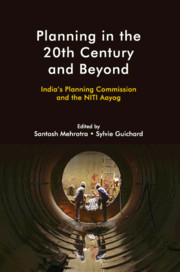Book contents
- Frontmatter
- Contents
- List of Figures
- List of Tables
- List of Abbreviations
- 1 Planning for a 21st Century India
- Part I Origins: Ideas and Ideology
- 2 From Economists to Historians: Studying the Planning Commission, 1950–2014
- 3 The Long Road to Indian Economic Planning (until 1950)
- 4 Ideas and Origins of the Planning Commission in India
- Part II Changes and Continuity: Development and Adaptation of Planning and the Planning Commission
- 5 The Planning Commission and Education
- 6 Addressing Agrarian Distress: Sops versus Development
- 7 Economic Planning after Economic Liberalization: Between Planning Commission and Think Tank NITI, 1991–2015
- 8 Planning Commission: Obiter Dictum
- 9 On a Revived Planning Commission
- Part III Planning Beyond the Planning Commission
- 10 Make in India
- 11 Manufacturing: The Cornerstone of a Planning Strategy for the 21st Century
- 12 Fiscal Planning to Sustain Growth and Poverty Reduction
- 13 Plan, but Do Not Over-plan: Lessons for NITI Aayog
- 14 Why Does India Need a Central Planning Institution in the 21st Century?
- Notes on Contributors
- Index
- References
7 - Economic Planning after Economic Liberalization: Between Planning Commission and Think Tank NITI, 1991–2015
Published online by Cambridge University Press: 04 April 2020
- Frontmatter
- Contents
- List of Figures
- List of Tables
- List of Abbreviations
- 1 Planning for a 21st Century India
- Part I Origins: Ideas and Ideology
- 2 From Economists to Historians: Studying the Planning Commission, 1950–2014
- 3 The Long Road to Indian Economic Planning (until 1950)
- 4 Ideas and Origins of the Planning Commission in India
- Part II Changes and Continuity: Development and Adaptation of Planning and the Planning Commission
- 5 The Planning Commission and Education
- 6 Addressing Agrarian Distress: Sops versus Development
- 7 Economic Planning after Economic Liberalization: Between Planning Commission and Think Tank NITI, 1991–2015
- 8 Planning Commission: Obiter Dictum
- 9 On a Revived Planning Commission
- Part III Planning Beyond the Planning Commission
- 10 Make in India
- 11 Manufacturing: The Cornerstone of a Planning Strategy for the 21st Century
- 12 Fiscal Planning to Sustain Growth and Poverty Reduction
- 13 Plan, but Do Not Over-plan: Lessons for NITI Aayog
- 14 Why Does India Need a Central Planning Institution in the 21st Century?
- Notes on Contributors
- Index
- References
Summary
As is well known, the Planning Commission (PC) was a venerable institution of the state that was initially envisioned and established in 1950 by India's first prime minister, Jawaharlal Nehru of the Congress Party, an iconic political hero of the nationalist movement. Sixty-five years later, on 1 January 2015, it stood officially abolished by another iconic leader, Prime Minister Narendra Modi, belonging to the Bharatiya Janata Party (BJP) – the avowedly Hindu-nationalist political adversary of the Congress Party, opposed to the economic philosophy and strategy of the Congress Party, indeed to much of the Nehruvian economic and political legacy. The formal ending of PC's reign had been preceded by an announcement by Prime Minister Modi from the ramparts of Delhi's historic Red Fort on India's 67th independence anniversary on 15 August 2014 about his government's intention to abolish the PC and replace it with another institution more in consonance with the changed economic and social environment.
It is understandable that a successor government with a historic mandate would want to put its own stamp on the institutional framework for economic policymaking. However, this chapter will attempt to demonstrate that, while the switch from the PC to the NITI Aayog (‘Policy Commission’, but more elaborately National Institution for Transforming India) clearly marks a rupture with the past institutionally, it also manifests the culmination of the evolutionary change that had been under way for some time in precisely that direction. It is true that some had seen the PC as a rigid, closed-minded, oversized bureaucratic organization with a set formulaic approach to economic planning. Indeed, an eminent PC member at the time of the abortive Sixth Five-Year Plan (FYP) (1978–1983), the late Raj Krishna, reportedly commented, when asked about the specific approach in that plan: ‘This is not the approach to the Sixth Plan. This is the sixth approach to the same plan’ (Goyal and Misra 2010). He thus alluded to the alleged lack of change in the PC's basic economic strategy. Notwithstanding that pronouncement of a highly perspicacious and esteemed economist, there is nonetheless a history of change in the PC's strategic thrust in response to contemporaneous challenges, starting with the switch to the heavy industry strategy in the second FYP (1956–1961) and the subsequent adoption of the Green Revolution agricultural strategy in the mid-1960s, both with enormous economic consequences.
- Type
- Chapter
- Information
- Planning in the 20th Century and BeyondIndia's Planning Commission and the NITI Aayog, pp. 132 - 151Publisher: Cambridge University PressPrint publication year: 2020



